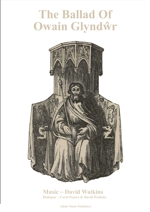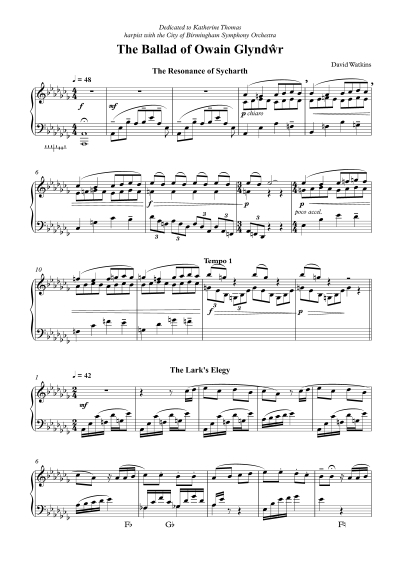 |
|||
| |
of Harp Music |
| © 2004-2025 ADLAIS |
| The Ballad of Owain Glyndŵr David Watkins Music, Carol Pearce & David Watkins Spoken Word |
return to previous page |
 |
Work: | Solo Pedal Harp with Optional Spoken Word |
| Catalogue No: | Adlais 234 | |
| ISMN: | 979-0-57032-302-9 | |
| Edition: | First Edition August 2025 A4 stapled | |
| Duration: | c. 10 minutes (solo) / c. 23 minutes (with spoken words) | |
| Suitable for: | Intermediate to Advanced Harpists | |
| Price:: | £12.00 Go to shop | |
| The Ballad of Owain Glyndŵr |
Composers Notes The text includes Iolo Goch’s extraordinary description of Owain Glyndŵr’s house, Sycharth, in the 14th century. Iolo Goch’s poem was written, in Welsh, in 1390. Our translation is based on one published in 1802 by Edward Jones, harpist to the Prince of Wales. The text has been divided up into a dialogue between Carol Pearce and David Watkins. There is one suggestion that will help the continuity of the piece, by not damping the resonance of the harp after the “Third Variation” and also after “The Prince of Wales”. If the “Ballad” is only performed as a harp solo, there are two solutions. A shorter version finishing after “The Soldiers Quick March” and a longer one finishing after “Owain Glyndwr Lost and Found”. Some of the text may be useful for programme notes or spoken by the harp soloist. Historical Background In 1066, the Normans invaded England and advanced into Wales. Over the years, English Kings and powerful barons strengthened their hold on Wales, despite many Welsh uprisings. In 1282, Llywelyn ap Gruffudd, Prince of Wales, was killed during a rebellion. In response, King Edward 1st built large castles in North Wales and conferred the title of Prince of Wales on his son. In 1400, Owain Glyndwr, a native born Welshman, was proclaimed Prince of Wales. He led a Wales-wide revolt, seeking an independent Wales, with its own government, Church and University. But, by 1415, the rebellion was over and Wales remained under English control. The University of Wales was established in 1893. The Church in Wales became independent in 1920. In 1999, a Parliament for Wales, known as the Senedd, was created, with some powers transferred from the UK government. David Watkins (2025) |
|

